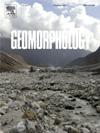被淹没的鼓浪原对海岸崖壁侵蚀的控制:马萨诸塞州波士顿港
IF 3.1
2区 地球科学
Q2 GEOGRAPHY, PHYSICAL
引用次数: 0
摘要
侵蚀的海岸峭壁给沿海社区带来了巨大的风险,要制定有效的管理策略,就必须加深对其侵蚀过程和机理的了解。波士顿港群岛由二十多个形成于晚更新世的溺水鼓浪岛组成,其中许多鼓浪岛现在由海湾连接。岛上裸露的悬崖受到海浪和降水的侵蚀,并日益受到海平面加速上升(SLR)的威胁。使用 ArcMap 10.8 的数字海岸线分析系统插件,根据正射影像(1995-2021 年)得出的鼓浪屿沿岸 31 块悬崖的退缩率为 0.0 米/年至 1.5 米/年。这些速率与多种因素有关,包括海岸线方向、外热带风暴期间的显著波高、耕层基质成分、基底标高、悬崖高度和工程结构的存在。研究发现,具有类似特征的崖群表明,高退缩率的崖群与波浪能量高、面向东北方向以及沙泥比高的崖群相吻合。波士顿港鼓状岩区域的复杂性和控制侵蚀的各个因素的多变性突出表明,开发一个预测侵蚀率的通用统计模型是不切实际的。更合适的方法是评估具有相似特征的悬崖群的趋势。可以采用类似的方法来探索其他海岸线上具有复杂或不规则悬崖系统和波浪场的退缩率的变化情况。本文章由计算机程序翻译,如有差异,请以英文原文为准。
Controls on coastal bluff erosion of a drowned drumlin field: Boston Harbor, Massachusetts
Eroding coastal bluffs pose significant risks to coastal communities, and an improved understanding of their erosional processes and mechanisms is essential for developing effective management strategies. The Boston Harbor Islands comprise more than two dozen drowned drumlins that were formed during the late-Pleistocene, many of which are now connected by spits. Exposed bluffs on the islands experience erosion due to waves and precipitation and are increasingly threatened by accelerating sea-level rise (SLR). Retreat rates for 31 bluffs along the drumlin shore, derived from orthoimagery (1995–2021) using the Digital Shoreline Analysis System add-in for ArcMap 10.8, range from 0.0 m/yr to 1.5 m/yr. These rates were examined in relation to several factors, including shoreline orientation, significant wave height during extratropical storms, till matrix composition, base elevation, bluff height, and presence of engineering structures. Clusters of bluffs with similar characteristics were identified, suggesting that high retreat rates coincide with bluffs that experience high wave energy, face the northeast and have high sand-to-mud ratios. The complexity of the Boston Harbor drumlin field and the variability of individual factors controlling erosion highlights the impracticality of developing a universal statistical model for predicting erosion rates. Rather a more suitable approach involves assessing trends among clusters of bluffs with similar characteristics. A similar approach can be taken for exploring the variability in retreat rates along other coastlines with complex or irregular bluff systems and wave fields.
求助全文
通过发布文献求助,成功后即可免费获取论文全文。
去求助
来源期刊

Geomorphology
地学-地球科学综合
CiteScore
8.00
自引率
10.30%
发文量
309
审稿时长
3.4 months
期刊介绍:
Our journal''s scope includes geomorphic themes of: tectonics and regional structure; glacial processes and landforms; fluvial sequences, Quaternary environmental change and dating; fluvial processes and landforms; mass movement, slopes and periglacial processes; hillslopes and soil erosion; weathering, karst and soils; aeolian processes and landforms, coastal dunes and arid environments; coastal and marine processes, estuaries and lakes; modelling, theoretical and quantitative geomorphology; DEM, GIS and remote sensing methods and applications; hazards, applied and planetary geomorphology; and volcanics.
 求助内容:
求助内容: 应助结果提醒方式:
应助结果提醒方式:


